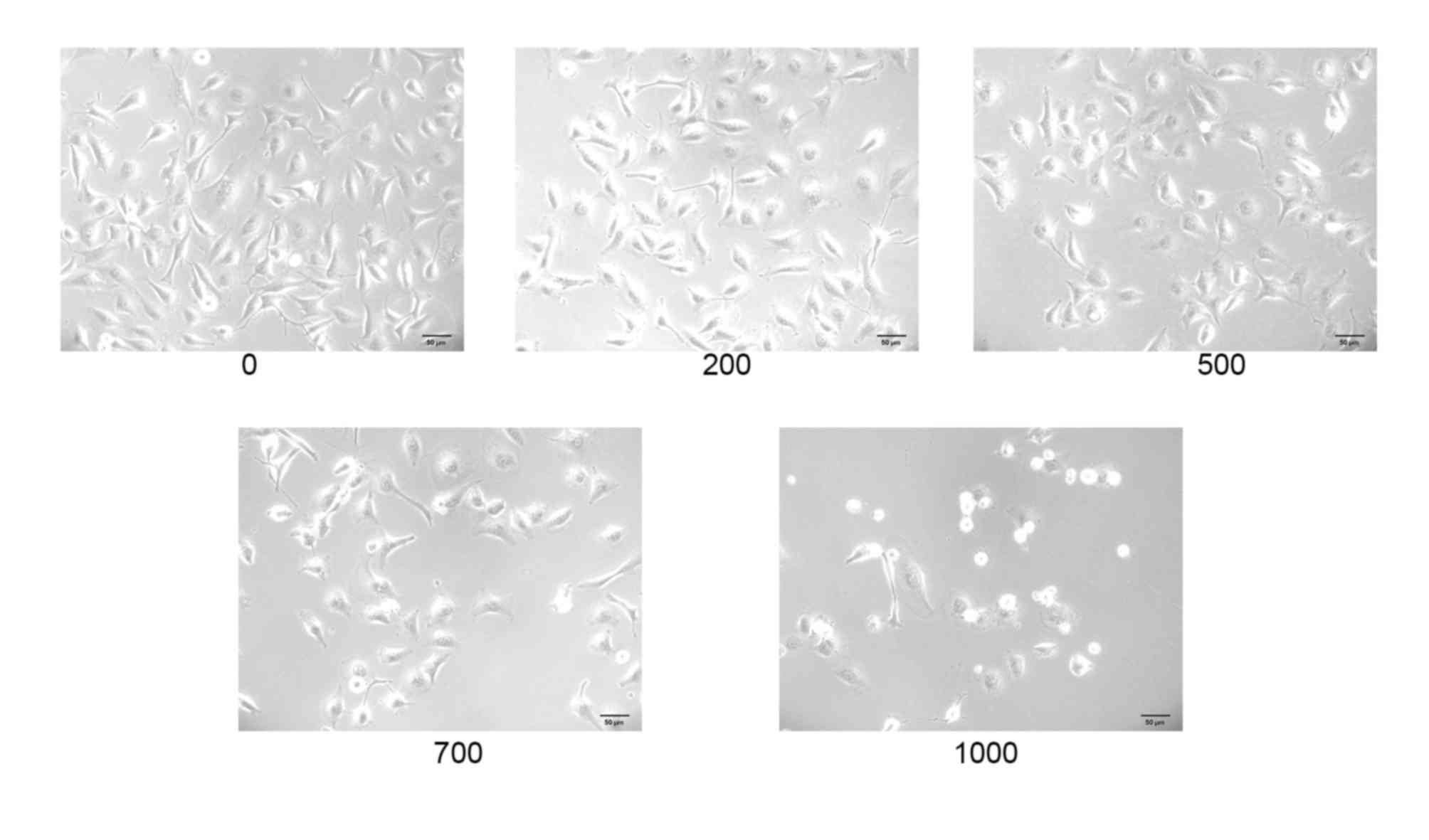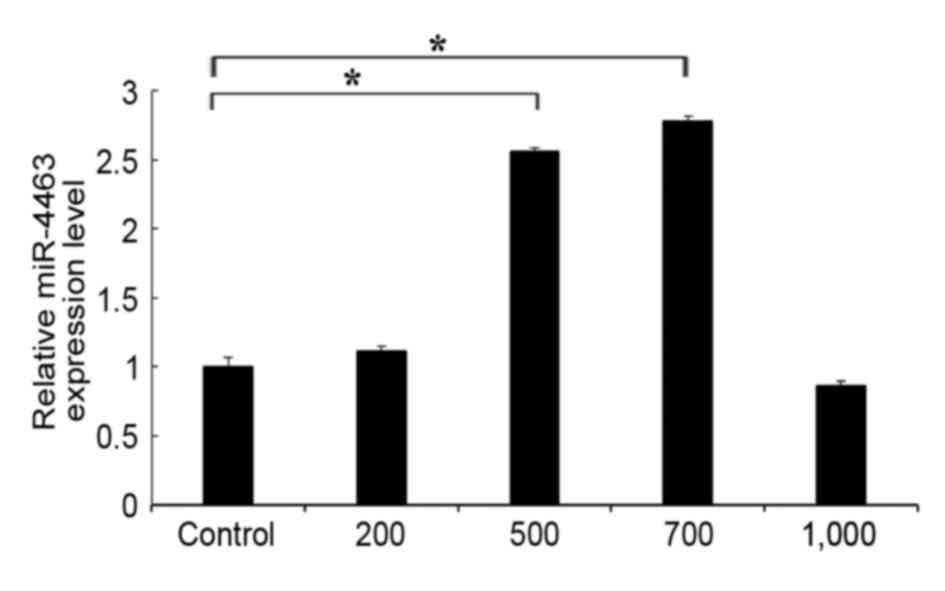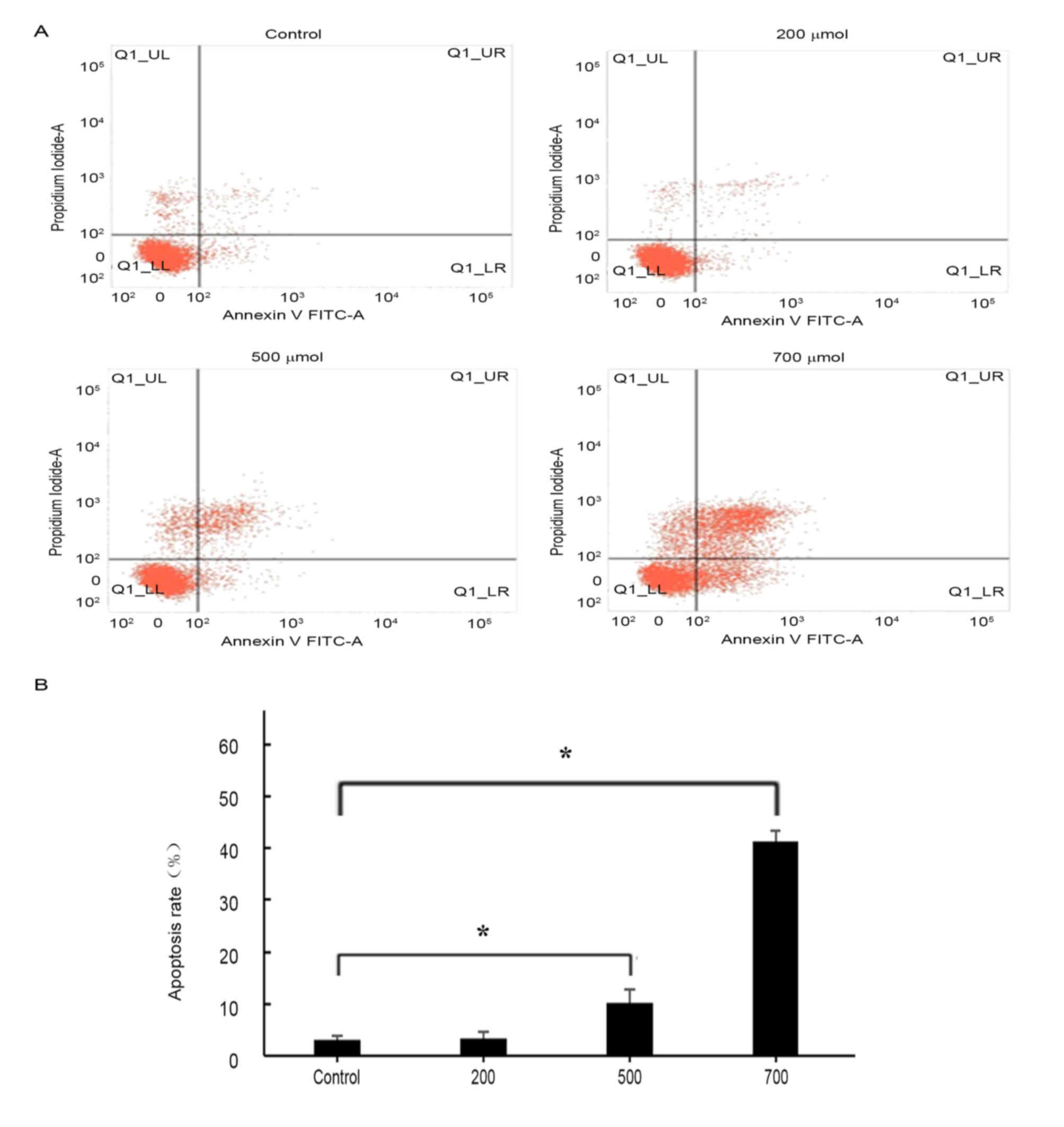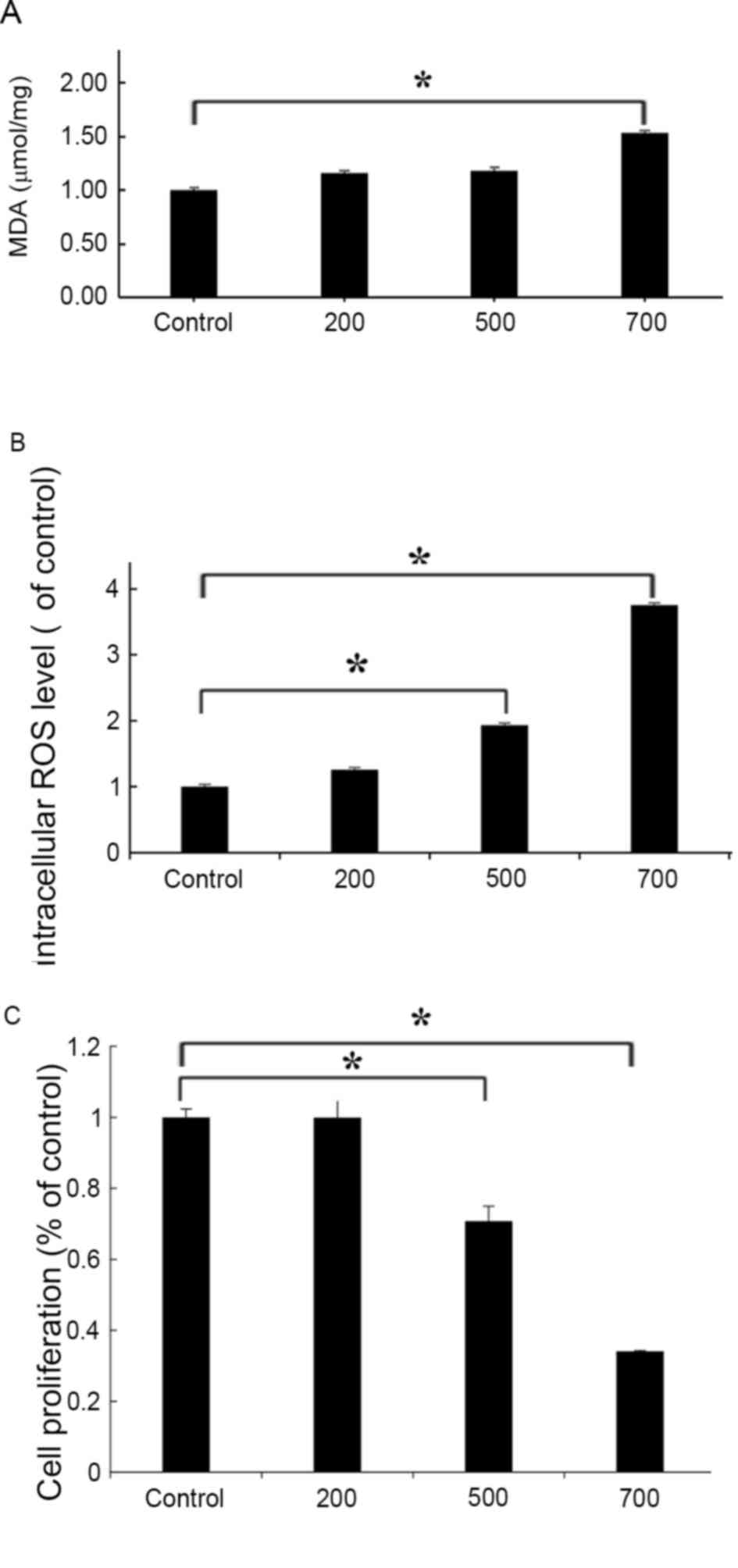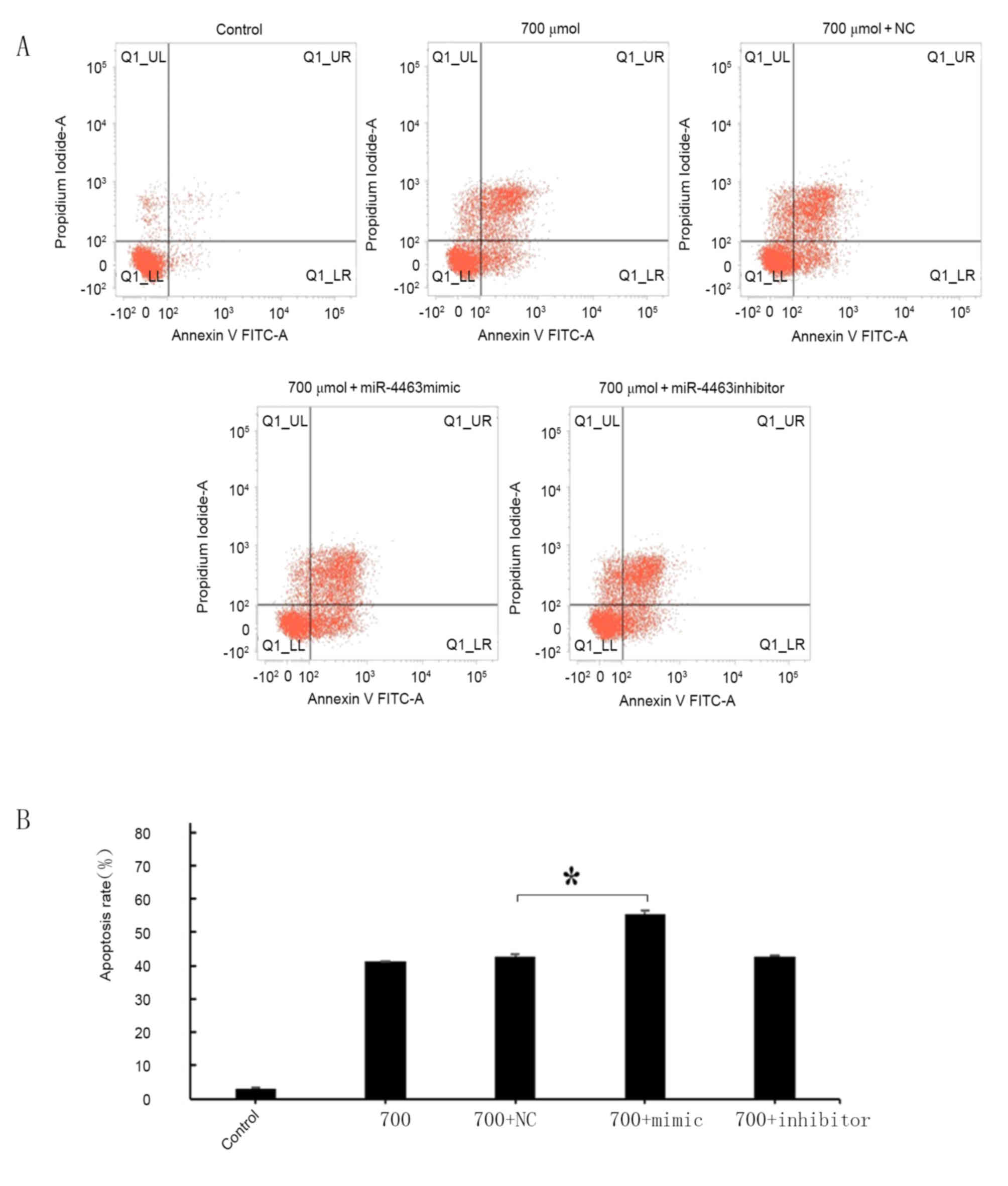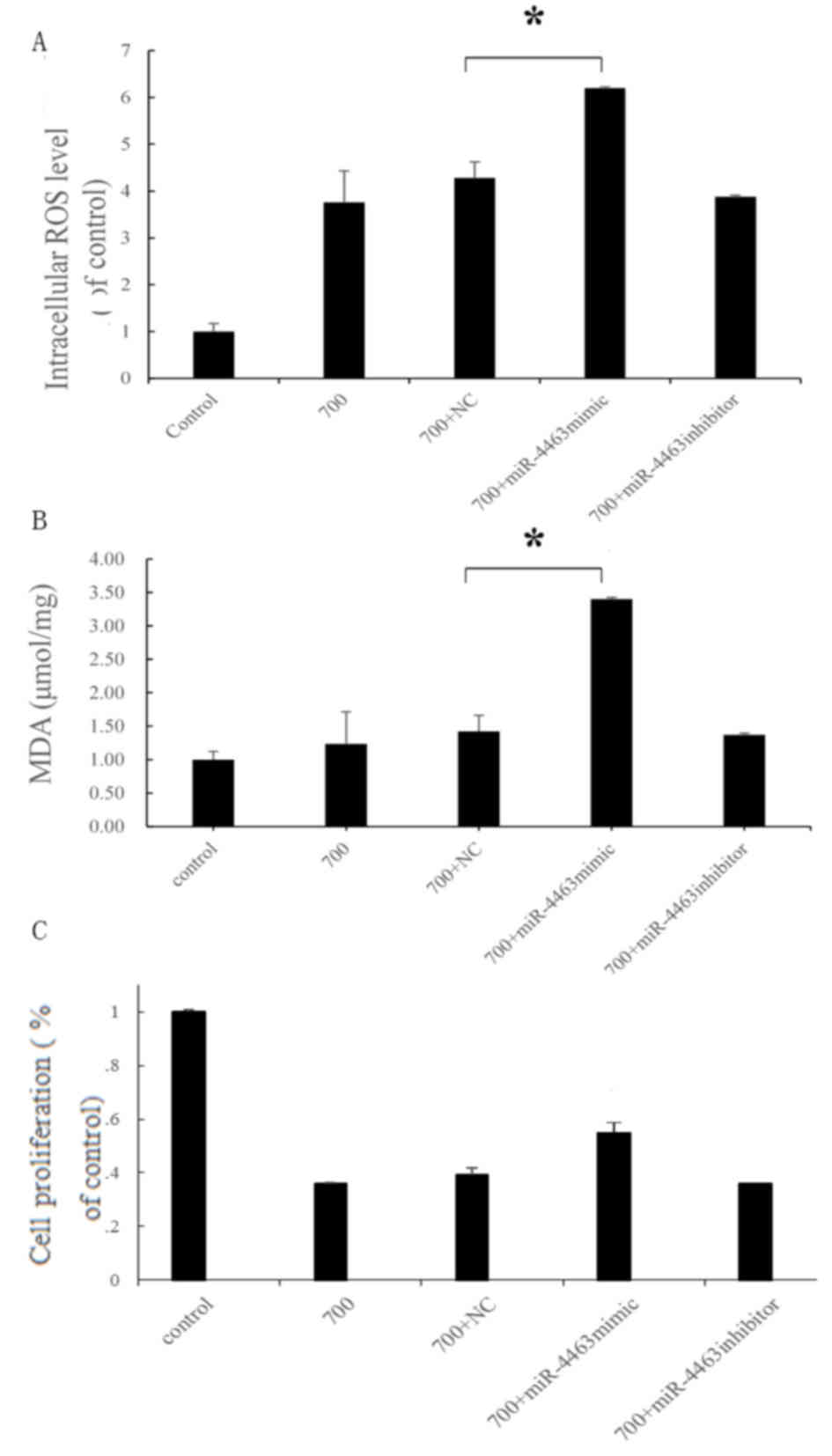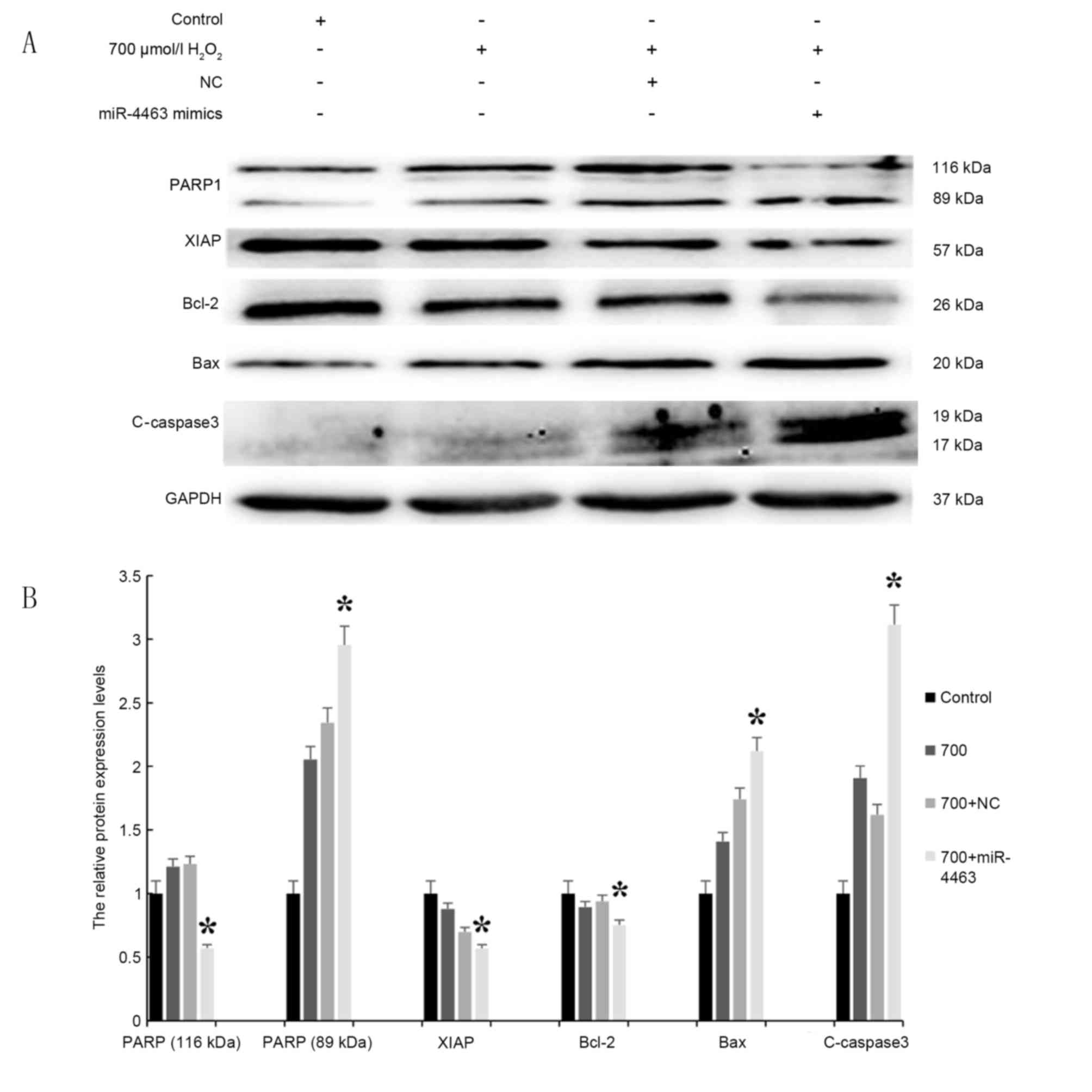Roles of miR‑4463 in H2O2‑induced oxidative stress in human umbilical vein endothelial cells
- Authors:
- Published online on: July 15, 2017 https://doi.org/10.3892/mmr.2017.7001
- Pages: 3242-3252
-
Copyright: © Wang et al. This is an open access article distributed under the terms of Creative Commons Attribution License.
Abstract
Introduction
Oxidative stress is an imbalance between oxidative and antioxidative processes in vivo and is involved in the pathogenesis of numerous diseases. Vascular disease is an inflammatory process, and oxidative stress has been implicated in vascular pathology (1,2). A previous study demonstrated that treatment with fucoidan, which is an aggregate name for algal fucose-enriched sulfated polysaccharides extracted from the extracellular matrix of seaweeds, may increase oxidative stress production by activating endothelial nitric oxide synthase and promoting Akt phosphorylation in myocardial disease and stroke (3). A recent study suggested that oxidative stress may be involved in high-fat diet-induced aortic remodeling, which may be exacerbated by Zn2+ deficiency, as the antioxidative molecule resveratrol was demonstrated to prevent high-fat diet-induced vascular inflammation, oxidative stress and pathological remodeling (4). Therefore, investigating the implications of oxidative stress in the pathogenesis of vascular diseases and exploring the underlying molecular mechanisms are imperative for the development of effective preventive and therapeutic strategies aimed at patients with vascular diseases.
Signaling pathways related to oxidative stress are associated with endothelial cells that line the inner walls of blood vessels, which are continuously exposed to various stresses owing to the mechanical force exerted by blood flow and pressure, and are sensitive to oxidative damage (5,6). A recent study demonstrated that the natural antioxidant allicin protected human umbilical vein endothelial cells (HUVECs) from oxidized low-density lipoprotein-induced injury by preventing apoptosis through the inhibition of caspase-3 and nicotinamide-adenine dinucleotide phosphate oxidase-mediated proapoptotic signaling (7). Another recent study reported that resveratrol (polyphenolic compounds) treatment ameliorated high glucose-induced HUVEC injury through the activation of 5′ adenosine monophosphate-activated protein kinase α, leading to an increase in reductive reactions and a corresponding decrease in oxidative stress (8). These studies suggested that oxidative stress may serve crucial roles during the development of vascular endothelial cell injury. Therefore, the present study aimed to investigate the effects of oxidative stress in HUVECs in vitro.
MicroRNAs (miRNAs) are small (~22 nucleotides long) non-coding RNA molecules, which modulate the stability and the translational efficiency of target mRNA transcripts (9). miRNAs are involved in the post-transcriptional regulation of gene expression and are implicated in numerous biological processes, including proliferation, differentiation, senescence and death (10). Previous studies have suggested that miRNAs may be involved in the regulation of oxidative stress during vascular disease pathogenesis, serving important roles in oxidative stress-induced endothelial dysfunction and mitochondrial metabolism dysregulation (1,11). Several miRNAs have been implicated in endothelial development, including miRNA (miR)-20a, miR-23b-3p, miR-150, miR-195 and miR-200b (11,12). Previous studies have also revealed crucial roles for miRNAs in endothelial physiology and pathology, thus suggesting that miRNAs may have potential as novel therapeutic targets for the treatment of patients with vascular diseases (13,14).
miR-4463 has garnered attention as a prognostic and diagnostic biomarker in patients with polycystic ovary syndrome (15). In addition, our previous studies have demonstrated the aberrant expression of miR-4463 in vascular diseases, including arteriosclerosis obliterans (16) and carotid artery stenosis (17), which suggested that miR-4463 may also have potential as a biomarker for the early diagnosis of vascular diseases. However, the roles of miR-4463 in the regulation of oxidative stress in endothelial cells, and the molecular mechanisms underlying its actions, have yet to be elucidated. Therefore, the present study aimed to investigate the putative relationship between miR-4463 and oxidative stress, and explore the molecular mechanisms that may be involved in HUVECs.
Materials and methods
Cell culture and oxidative stress model
The HUVEC cell line was purchased from ScienCell Research Laboratories, Inc. (Carlsbad, CA, USA) and cultured in low-glucose Dulbecco's modified Eagle's medium (DMEM; Hyclone, GE Healthcare Life Sciences, Logan, UT, USA), supplemented with 10% heat-inactivated fetal bovine serum (FBS; Gibco, Thermo Fisher Scientific, Inc., Waltham, MA, USA) and maintained in a humidified 5% CO2 atmosphere. Cells between passages 4 and 6, in the logarithmic phase of growth, were used in the subsequent experiments. The morphology of the cells was observed using a phase-contrast microscope (cellSens standard software version 1.6, DP72; Olympus Corporation, Tokyo, Japan).
Hydrogen peroxide (H2O2) is commonly used in models of oxidative stress-induced apoptosis (18). In the present study, HUVECs were treated with various concentrations of H2O2 (200, 500, 700 and 1,000 µmol/l; Table I) using 0.3% H2O2 stock solution, or 0 µl H2O2 (low-gluocse DMEM alone containing 10% FBS) for 16 h to induce oxidative stress, as previously described (19–21).
Transfection
The intracellular level of miR-4463 was upregulated or downregulated by the transfection of miRNA mimics and inhibitor respectively, according to the manufacturer's protocol (Guangzhou RiboBio Co., Ltd., Guangzhou, China). The miRNA mimics synthesized by the chemical method induces a high level of expression of mature miRNA in the cell, and it enhances the regulation of endogenous miRNA and gains certain functions in cells. miRNA inhibitors inhibit the effects of mature miRNA, and weaken the role of endogenous gene regulation and cell function. When the cell density reached 50–70%, the transfection efficiency was optimal (Table II). Transfection was performed using 100 µmol/l miR-4463 mimic or inhibitor for 15 min at room temperature, and the efficiency of transfection was determined by RT-qPCR. Finally, 100 nmol/l NC, miR-4463 mimics and miR-4463 inhibitor was chosen for the next step after 3 days transfection. NC, miR-4463 mimics and miR-4463 inhibitor sequences are listed on the Guangzhou RiboBio Co., Ltd. Website: http://ribobio.bioon.com.cn.
RNA exaction and reverse transcription-quantitative polymerase chain reaction (RT-qPCR)
Following treatment with H2O2, total RNA was extracted from HUVECs (2–3×105 cells) using TRIzol reagent (Invitrogen; Thermo Fisher Scientific, Inc.). Total RNA (500 ng) was reverse transcribed into cDNA using an miScript II RT kit (catalog no. 218160 and 21816; Qiagen GmbH, Hilden, Germany), according to manufacturer's protocol. The specific reaction components of reverse-transcription are mentioned in Table III. The mix was incubated for 60 min at 37°C, incubated for 5 min at 95°C and stored at −20°C. Acquired cDNA was used for RT-qPCR according to the manufacturer's protocol using the miScript SYBR-Green PCR kit (catalog no. 208054; Qiagen GmbH). Mature has-miR-4463 primer (catalog no. MIMAT0018987) and U6 primer (catalog no. MS00044996) were purchased from Qiagen GmbH. The specific reaction components of RT-qPCR are mentioned in Table IV, and the cycling conditions are mentioned in Table V. qPCR was performed using the StepOnePlus version 2.2.3 real-time PCR system (Applied Biosystems; Thermo Fisher Scientific, Inc.). Relative expression levels were quantified using the 2−ΔΔCq method (22) and normalized to the expression of U6; Ct values >35 were excluded. Experiments were performed in triplicate.
Apoptosis assay
Apoptosis and necrosis were assessed using the fluorescein isothiocyanate (FITC) Annexin V and propidium iodide (PI) detection kit (BD Pharmingen; BD Biosciences, Franklin Lakes, NJ, USA), according to the manufacturer's protocol. Following treatment with H2O2, HUVECs (5×105 cells) were washed with 10X Annexin V binding buffer, and stained for 10 min with 5 µl FITC Annexin V and 5 µl PI at room temperature in the dark. Stained cells were analyzed by flow cytometry using a BD FACSVerse and BD FACSuite™ software version 1.0.3 (BD Biosciences), and the experiment was repeated three times.
Oxidative stress assays
Reactive oxygen species (ROS) production and lipid peroxidation were measured in order to assess oxidative stress in HUVECs, using ROS and malondialdehyde (MDA) detection kits (Beyotime Institute of Biotechnology, Haimen, China). Experiments were repeated >3 times. To detect ROS production, H2O2-treated HUVECs (1×105 cells) were incubated with the fluorescent probe 2′,7′-dichlorodihydrofluorescein diacetate (chloromethyl derivative) at 37°C for 30 min, as previously described (23–25). Subsequently, samples were digested by trypsin-EDTA solution (Beyotime Institute of Biotechnology), centrifuged (1,000 × g for 5 min at room temperature) and transferred to black 96-well plates. The fluorescence was measured using an excitation wavelength of 488 nm and an emission wavelength of 525 nm using a microplate reader. MDA is a natural product of lipid oxidation in organisms. The level of lipid oxidation may be measured by detecting the level of MDA, and therefore the determination of MDA is widely used as an indicator of lipid oxidation. To assess MDA contents in HUVECs (1×105 cells), cells were lysed and then centrifuged (1,600 × g for 10 min at 4°C). A total of 100 µl supernatant and 200 µl MDA detection working fluid (150 µl TBA dilute solution, 50 µl TBA storage solution and 3 µl antioxidant) were mixed, heated at 100°C for 15 min and cooled to room temperature. The reaction mixture was centrifuged (1,000 × g for 10 min at room temperature), and subsequently transferred to 96-well plates and the absorbance was measured at 532 nm using a microplate reader, as previously described (26,27).
Cell proliferation assay
Cellular proliferation was evaluated using a Cell Counting Kit-8 (CCK-8; Beyotime Institute of Biotechnology), as previously described (28,29). Following treatment with H2O2 for 16 h, HUVECs (1×104 cells/well) were seeded in 96-well plates (5 wells/experimental group) in 100 µl serum-free DMEM (Hyclone; GE Healthcare Life Sciences) and 10 µl CCK-8 solution were added to each well and cells were incubated at 37°C for 35 min. The absorbance of each sample was measured at 450 nm using a microplate reader as previously described (30). The percentage of living cells was calculated as a ratio of the optical density of treated cells over untreated control cells.
Western blot analysis
Following treatment with H2O2, total protein was extracted from HUVECs (2×106 cells) using Radioimmunoprecipitation Assay Lysis buffer (Beyotime Institute of Biotechnology) as previously described (2,31). Equal amounts (20 µg) of protein in each sample (extracted using a bicinchoninic acid assay) were separated by 12% SDS-PAGE and transferred onto polyvinylidene difluoride membranes. Then, membranes were blocked for 2 h in 0.5% nonfat milk at room temperature, and washed three times for 5 mins with PBS containing 0.1% Tween-20. Next, membranes were incubated with the following primary antibodies at 4°C overnight: Anti-poly (adenosine diphosphate-ribose) polymerase 1 (PARP1; 1:1,000; catalog no. 9532), anti-X-linked inhibitor of apoptosis protein (XIAP; 1:1,000; catalog no. 14334), and anti-B cell lymphoma-2 (Bcl-2)-associated X protein (Bax; 1:1,000; catalog no. 14796) were purchased from Cell Signaling Technology, Inc. (Danvers, MA, USA); anti-active (cleaved)-caspase-3 (C-caspase-3; 1:500; catalog no. ab32042) was purchased from Abcam (Cambridge, UK); and anti-Bcl-2 (1:1,000; catalog no. AB112-1) and anti-GAPDH (1:2,000; catalog no. AF0006) were purchased from Beyotime Institute of Biotechnology. GAPDH served as the loading control (18,19). Subsequently, membranes were incubated with the following horseradish peroxidase-conjugated secondary antibodies for 1 h at 37°C: Anti-rabbit immunoglobulin (Ig)G (1:2,000; catalog no. A0208) and anti-mouse IgG (1:3,000; catalog no. A0216) purchased from Beyotime Institute of Biotechnology. Protein bands were visualized by enhanced chemiluminescence detection reagent (Bio-Rad Laboratories, Inc., Hercules, CA, USA), and blots were semi-quantified by densitometric analysis using Quantity One version 4.6.2 software (Bio-Rad Laboratories, Inc.). Experiments were performed >3 times.
Statistical analysis
Statistical analysis was performed using SPSS software version 19.0 (IBM Corp., Armonk, NY, USA). Data are expressed as the mean ± standard deviation. The statistical significance of the differences between groups was assessed using one-way analysis of variance followed by a post hoc Dunnett's two-tailed test for multiple comparisons. P<0.05 was considered to indicate a statistically significant difference.
Results
Alterations in HUVEC morphology and miR-4463 expression following treatment with H2O2
When examined under an inverted phase-contrast microscope, HUVECs in the untreated control group exhibited physiological morphology, characterized by spindle- or round-shaped cell architecture, cells that were adherent and formed paving stone-like cultures (32,33). Conversely, the number of HUVECs in culture appeared to be markedly reduced following H2O2 treatment, with undefined boundaries and observable necrotic and disintegrative phenomena among the cells, which concurred with previously published data (34–36) (Fig. 1).
The expression levels of miR-4463 were assessed in HUVECs treated with various concentrations of H2O2. The results demonstrated that miR-4463 expression levels were significantly upregulated in H2O2-treated HUVECs in a dose-dependent manner compared with in untreated control cells (Fig. 2). miR-4463 expression appeared to be the highest following treatment with H2O2 at a concentration of 700 µmol/l. The high concentration of H2O2 (1,000 µmol/l) may promote cell death and inhibit the expression of the cells under oxidative stress.
H2O2 induces apoptosis in HUVECs
Flow cytometric analysis revealed that treatment with H2O2 was able to induced apoptosis in HUVECs (Fig. 3). Annexin V-positive cells and cellular uptake of PI were evaluated in order to distinguish between living, apoptotic and necrotic cells, as previously described (37). The proapoptotic effects of H2O2 treatment appeared to be concentration-dependent (Fig. 3B): No significant difference in the apoptotic rate was detected following treatment with 200 µmol/l H2O2; however, HUVEC apoptosis was significantly increased following treatment with 500 and 700 µmol/l H2O2 compared with control untreated cells (P<0.05). As H2O2 at a concentration of 700 µmol/l appeared to produce the greatest increase in apoptotic rate (43%) and necrotic rate (8.25%), this concentration was selected for subsequent experiments.
H2O2 induces oxidative stress in HUVECs
To confirm the induction of oxidative stress following H2O2 treatment in HUVECs, oxidative stress products were detected and cellular viability was evaluated, using commercially available kits. MDA is an end product of lipid oxidation that is involved in the oxidative damage of the cellular membrane; therefore, MDA contents may be measured as an indication of the degree of lipid peroxidation and the extent of membrane damage (38,39). In HUVECs treated with 700 µmol/l H2O2, MDA levels were increased by 1.5-fold compared with the untreated control cells (P<0.05; Fig. 4A); whereas no significant differences were indicated in HUVECs treated with 200 or 500 µmol/l H2O2. In addition, intracellular ROS production was significantly enhanced in H2O2-treated cells, as indicated by the 3.75-fold increase in ROS levels following treatment with 700 µmol/l H2O2 compared with the control. Treatment with 500 µmol/l H2O2 increased ROS levels by ~2-fold compared with the control, and there was no significant increase after treatment with 200 µmol/l H2O2 (Fig. 4B). Notably, no significant difference in cellular proliferation was detected between 200 µmol/l H2O2-treated HUVECs and control cells (Fig. 4C). However, cell proliferation and viability was significantly reduced following treatment with 500 or 700 µmol/l H2O2 (Fig. 4C). These findings suggested that treatment with H2O2 may induce oxidative stress in HUVECs and suppress their viability in a concentration-dependent manner.
miR-4463 promotes H2O2-induced increases in oxidative stress
The apoptotic rate of HUVECs pretreated with miR-4463 mimics prior to H2O2 exposure was significantly increased compared with negative control-treated H2O2-exposed cells (Fig. 5), thus suggesting that miR-4463 may serve a role in promoting apoptosis following H2O2 treatment. Detecting NC-treated H2O2 as the control group eliminates any background effects of the transfection reagent. The roles of miR-4463 in H2O2-induced oxidative stress were also investigated, and the results revealed that intracellular ROS and MDA levels were significantly increased in H2O2-treated HUVECs following transfection with miR-4463 mimics; however, the miR-4463 inhibitor did not induce a significant difference. This suggested that miR-4463 overexpression enhanced H2O2-induced oxidative stress (Fig. 6A and B). However, the miR-4463 mimics did not have an exact effect on cell proliferation (Fig. 6C). These findings suggested that miR-4463 may enhance oxidative stress on HUVECs but have no apparent effect on the proliferation of HUVECs.
miR-4463 promotes proapoptotic signaling in H2O2-treated HUVECs. The protein expression levels of pro- and antiapoptotic markers, including C-caspase-3, Bax, Bcl-2, XIAP and PARP1, were detected in H2O2-treated HUVECs by western blot analysis (Fig. 7). The results demonstrated that following H2O2 treatment, the expression levels of the antiapoptotic proteins Bcl-2 and XIAP were downregulated, whereas the expression of the proapoptotic C-caspase3, PARP1 and Bax was enhanced. Notably, HUVECs pretreated with miR-4463 mimics prior to H2O2 exposure exhibited significantly increased C-caspase3, cleaved PARP and Bax protein expression levels, whereas the expression of Bcl-2 and XIAP was significantly suppressed. The present findings suggested that miR-4463 overexpression may increase the proapoptotic effects of H2O2 on HUVECs.
Discussion
miRNAs are able to combine with complementary sequences in the 3′-untranslated region of target mRNA transcripts, and thus regulate the transcription of target genes and ultimately inhibit the translation of specific proteins (9). miRNAs have been demonstrated previously to be involved in the regulation of HUVEC proliferation, migration and apoptosis (12). In addition, miRNAs have been associated with processes involved in the development of oxidative stress (24). However, the roles of miRNAs in the pathophysiology of vascular diseases, as well as their clinical value, have yet to be elucidated. Our previous study reported that miR-4463 has a greater change in the plasma levels of vascular patients (16). Therefore, the present study hypothesized that miR-4463 may have an effect on the pathophysiological processes associated with vascular diseases.
H2O2 is one of the main ROS, which has been reported to decrease cellular proliferation and induce apoptosis, in a process involving several miRNAs (28). Exposure of endothelial cells to H2O2 has been reported to cause cell dysfunction and promote apoptosis, thus inducing endothelial inflammation. For example, Yu et al (40) previously demonstrated that miR-200c expression was upregulated following 100 µmol/l H2O2 treatment in BV-2 mouse microglial cells in vitro, whereas Zhang et al (38) reported that miR-92a overexpression in HUVECs enhanced capillary tube formation under conditions of oxidative stress. The present study investigated the expression of miR-4463 in H2O2-treated HUVECs, and RT-qPCR analysis revealed that miR-4463 expression was upregulated following treatment with H2O2 in a concentration-dependent manner. Notably, in HUVECs treated with 1,000 µmol/l H2O2, miR-4463 expression was comparable to baseline levels. Yu et al (40) also reported similar changes in miR-200c expression levels following spinal cord injury in murine BV-2 cells; however, the reason remains unclear and further studies are required to investigate whether high H2O2 concentration (1,000 µmol/l) may increase cell necrosis. Regardless of this discrepancy, the present results suggested that miR-4463 may serve a role in oxidative processes in HUVECs, and its expression may be regulated by H2O2 in a concentration-dependent manner.
Oxidative stress has been implicated in cellular apoptosis. In the present study, HUVEC apoptosis was investigated using flow cytometry following cell exposure to H2O2. The present results demonstrated that H2O2 increased the apoptotic rate in HUVECs in a concentration-dependent manner. Once generated, ROS readily react with unsaturated fatty acids and cholesterol molecules present in cell membranes, thus leading to cellular apoptosis through mitochondrial pathways involving nuclear factor-κB, p53 and stress-activated protein kinase (41). In the present study, oxidative stress was investigated in HUVECs by assessing ROS production and MDA concentration; the results of which revealed that ROS and MDA levels were significantly increased following H2O2 treatment, whereas cell viability was significantly reduced, thus indicating that H2O2 was able to induced apoptosis in HUVECs, which is in accordance with previous studies (27,37).
To investigate the roles of miR-4463 in oxidative pathways and cellular apoptosis, HUVECs were transfected with miR-4463 mimics or inhibitors prior to H2O2 exposure. The present results demonstrated that the apoptotic rate and the levels of oxidation products were significantly increased in HUVECs overexpressing miR-4463. However, miR-4463 inhibition did not produce a significant effect. These results suggested that miR-4463 upregulation may enhance H2O2-induced HUVEC apoptosis; however, further studies are required to confirm the exact roles of miR-4463 in HUVECs under oxidative stress and to determine the possible underlying molecular mechanisms that are involved.
Oxidative stress is a harmful mechanism for self-protection, therefore, excessive activation may enhance this effect. The results of the present study revealed that H2O2 treatment altered miR-4463 expression in HUVECs, and miR-4463 overexpression enhanced H2O2-induced oxidative stress. Therefore, the molecular mechanisms underlying the involvement of miR-4463 in apoptotic pathways were investigated in HUVECs, by assessing the expression levels of apoptosis-associated marker proteins. Following miR-4463 overexpression in H2O2-treated HUVECs, the proapoptotic proteins C-caspase3, PARP1 and Bax were significantly upregulated, whereas the protein expression of the anti-apoptotic effectors Bcl-2 and XIAP was significantly reduced. These findings suggested that miR-4463 may be implicated in the regulation of apoptosis-related protein expression in HUVECs treated with H2O2. However, further studies are required to fully elucidate the roles of miR-4463 and its target genes in apoptotic pathways.
In conclusion, the present results suggested that miR-4463 may be implicated in the pathogenesis of cardiovascular disease through the regulation of oxidative processes. Future studies will address the roles of specific target genes during the regulation of HUVEC oxidative stress and apoptosis, and the effects of miRNAs in the pathophysiological mechanisms involved in oxidative processes will be explored. The results of the present study suggested that miR-4463 may have potential for the development of novel strategies for the diagnosis, prognosis and treatment of cardiovascular diseases.
References
|
Ono K: MicroRNA-133a in the development of arteriosclerosis obliterans. J Atheroscler Thromb. 22:342–343. 2015. View Article : Google Scholar : PubMed/NCBI | |
|
Rajput C, Tauseef M, Farazuddin M, Yazbeck P, Amin MR, Br V Avin, Sharma T and Mehta D: MicroRNA-150 suppression of angiopoetin-2 generation and signaling is crucial for resolving vascular injury. Arterioscler Thromb Vasc Biol. 36:380–388. 2016. View Article : Google Scholar : PubMed/NCBI | |
|
Li X, Li J, Li Z, Sang Y, Niu Y, Zhang Q, Ding H and Yin S: Fucoidan from Undaria pinnatifida prevents vascular dysfunction through PI3K/Akt/eNOS-dependent mechanisms in the l-NAME-induced hypertensive rat model. Food Funct. 7:2398–2408. 2016. View Article : Google Scholar : PubMed/NCBI | |
|
Guo R, Li W, Liu B, Li S, Zhang B and Xu Y: Resveratrol protects vascular smooth muscle cells against high glucose-induced oxidative stress and cell proliferation in vitro. Med Sci Monit Basic Res. 20:82–92. 2014. View Article : Google Scholar : PubMed/NCBI | |
|
Csordas A, Kreutmayer S, Ploner C, Braun PR, Karlas A, Backovic A, Wick G and Bernhard D: Cigarette smoke extract induces prolonged endoplasmic reticulum stress and autophagic cell death in human umbilical vein endothelial cells. Cardiovasc Res. 92:141–148. 2011. View Article : Google Scholar : PubMed/NCBI | |
|
Jeon BK, Kwon K, Kang JL and Choi YH: Csk-induced phosphorylation of Src at tyrosine 530 is essential for H2O2-mediated suppression of ERK1/2 in human umbilical vein endothelial cells. Sci Rep. 5:127252015. View Article : Google Scholar : PubMed/NCBI | |
|
Chen X, Pang S, Lin J, Xia J and Wang Y: Allicin prevents oxidized low-density lipoprotein-induced endothelial cell injury by inhibiting apoptosis and oxidative stress pathway. BMC Complement Altern Med. 16:1332016. View Article : Google Scholar : PubMed/NCBI | |
|
Zhou DY, Su Y, Gao P, Yang QH, Wang Z and Xu Q: Resveratrol ameliorates high glucose-induced oxidative stress injury in human umbilical vein endothelial cells by activating AMPK. Life Sci. 136:94–99. 2015. View Article : Google Scholar : PubMed/NCBI | |
|
Zheng D, Yu Y, Li M, Wang G, Chen R, Fan GC, Martin C, Xiong S and Peng T: Inhibition of microRNA 195 prevents apoptosis and multiple-organ injury in mouse models of sepsis. J Infect Dis. 213:1661–1670. 2016. View Article : Google Scholar : PubMed/NCBI | |
|
Hecker M, Thamilarasan M, Koczan D, Schröder I, Flechtner K, Freiesleben S, Füllen G, Thiesen HJ and Zettl UK: MicroRNA expression changes during interferon-beta treatment in the peripheral blood of multiple sclerosis patients. Int J Mol Sci. 14:16087–16110. 2013. View Article : Google Scholar : PubMed/NCBI | |
|
Zhao S, Li T, Li J, Lu Q, Han C, Wang N, Qiu Q, Cao H, Xu X, Chen H and Zheng Z: miR-23b-3p induces the cellular metabolic memory of high glucose in diabetic retinopathy through a SIRT1-dependent signalling pathway. Diabetologia. 59:644–654. 2016. View Article : Google Scholar : PubMed/NCBI | |
|
Li X, Yao N, Zhang J and Liu Z: MicroRNA-125b is involved in atherosclerosis obliterans in vitro by targeting podocalyxin. Mol Med Rep. 12:561–568. 2015.PubMed/NCBI | |
|
Correia AC, Moonen JR, Brinker MG and Krenning G: FGF2 inhibits endothelial-mesenchymal transition through microRNA-20a-mediated repression of canonical TGF-b signaling. J Cell Sci. 129:569–579. 2016. View Article : Google Scholar : PubMed/NCBI | |
|
Savoia C, Sada L, Zezza L, Pucci L, Lauri FM, Befani A, Alonzo A and Volpe M: Vascular inflammation and endothelial dysfunction in experimental hypertension. Int J Hypertens. 2011:2812402011. View Article : Google Scholar : PubMed/NCBI | |
|
Ding CF, Chen WQ, Zhu YT, Bo YL, Hu HM and Zheng RH: Circulating microRNAs in patients with polycystic ovary syndrome. Hum Fertil (Camb). 18:22–29. 2015. View Article : Google Scholar : PubMed/NCBI | |
|
He XM, Zheng YQ, Liu SZ, Liu Y, He YZ and Zhou XY: Altered plasma microRNAs as novel biomarkers for arteriosclerosis obliterans. J Atheroscler Thromb. 23:196–206. 2016. View Article : Google Scholar : PubMed/NCBI | |
|
Lu G, Wong MS, Xiong MZQ, Leung CK, Su XW, Zhou JY, Poon WS, Zheng VZY, Chan WY and Wong GKC: Circulating MicroRNAs in delayed cerebral infarction after aneurysmal subarachnoid hemorrhage. J Am Heart Assoc. 6:pii: e005363. 2017. View Article : Google Scholar | |
|
Liu X and Sun J: Endothelial cells dysfunction induced by silica nanoparticles through oxidative stress via JNK/P53 and NF-kappaB pathways. Biomaterials. 31:8198–8209. 2010. View Article : Google Scholar : PubMed/NCBI | |
|
Lesniewska MA, Dereziński P, Klupczyńska A, Kokot ZJ, Ostrowski T, Zeidler J and Muszalska I: HPLC and HPLC/MS/MS studies on stress, accelerated and intermediate degradation tests of antivirally active tricyclic analog of acyclovir. J AOAC Int. 98:1240–1247. 2015. View Article : Google Scholar : PubMed/NCBI | |
|
Lennicke C, Rahn J, Lichtenfels R, Wessjohann LA and Seliger B: Hydrogen peroxide - production, fate and role in redox signaling of tumor cells. Cell Commun Signal. 13:392015. View Article : Google Scholar : PubMed/NCBI | |
|
Zhang H, Sheng C, Yin Y, Wen S, Yang G, Cheng Z and Zhu Q: PABPC1 interacts with AGO2 and is responsible for the microRNA mediated gene silencing in high grade hepatocellular carcinoma. Cancer Lett. 367:49–57. 2015. View Article : Google Scholar : PubMed/NCBI | |
|
Livak KJ and Schmittgen TD: Analysis of relative gene expression data using real-time quantitative PCR and the 2(−Delta Delta C(T)) method. Methods. 25:402–408. 2001. View Article : Google Scholar : PubMed/NCBI | |
|
Nagababu P, Barui AK, Thulasiram B, Devi CS, Satyanarayana S, Patra CR and Sreedhar B: Antiangiogenic activity of mononuclear copper(II) polypyridyl complexes for the treatment of cancers. J Med Chem. 58:5226–5241. 2015. View Article : Google Scholar : PubMed/NCBI | |
|
Ma Y and Li W, Yin Y and Li W: AST IV inhibits H2O2-induced human umbilical vein endothelial cell apoptosis by suppressing Nox4 expression through the TGF-β1/Smad2 pathway. Int J Mol Med. 35:1667–1674. 2015.PubMed/NCBI | |
|
Yan S, Zhang X, Zheng H, Hu D, Zhang Y, Guan Q, Liu L, Ding Q and Li Y: Clematichinenoside inhibits VCAM-1 and ICAM-1 expression in TNF-α-treated endothelial cells via NADPH oxidase-dependent IκB kinase/NF-κB pathway. Free Radic Biol Med. 78:190–201. 2015. View Article : Google Scholar : PubMed/NCBI | |
|
Liu S, Luo R, Xiang Q, Xu X, Qiu L and Pang J: Design and synthesis of novel xyloketal derivatives and their protective activities against H2O2-induced HUVEC injury. Mar Drugs. 13:948–973. 2015. View Article : Google Scholar : PubMed/NCBI | |
|
Hou X, Tong Q, Wang W, Xiong W, Shi C and Fang J: Dihydromyricetin protects endothelial cells from hydrogen peroxide-induced oxidative stress damage by regulating mitochondrial pathways. Life Sci. 130:38–46. 2015. View Article : Google Scholar : PubMed/NCBI | |
|
Wu W, Zhang D, Pan D, Zuo G, Ren X and Chen S: Downregulation of vascular endothelial growth factor receptor-2 under oxidative stress conditions is mediated by b-transduction repeat-containing protein via glycogen synthase kinase-3b signaling. Int J Mol Med. 37:911–920. 2016.PubMed/NCBI | |
|
Chen AY, Lü JM, Yao Q and Chen C: Entacapone is an antioxidant more potent than vitamin C and vitamin E for scavenging of hypochlorous acid and peroxynitrite and the inhibition of oxidative stress-induced cell death. Med Sci Monit. 22:687–696. 2016. View Article : Google Scholar : PubMed/NCBI | |
|
Zhang HB, Wen JK, Zhang J, Miao SB, Ma GY, Wang YY, Zheng B and Han M: Flavonoids from Inula britannica reduces oxidative stress through inhibiting expression and phosphorylation of p47(phox) in VSMCs. Pharm Biol. 49:815–820. 2011. View Article : Google Scholar : PubMed/NCBI | |
|
Fetahu IS, Tennakoon S, Lines KE, Gröschel C, Aggarwal A, Mesteri I, Baumgartner-Parzer S, Mader RM, Thakker RV and Kállay E: miR-135b- and miR-146b-dependent silencing of calcium-sensing receptor expression in colorectal tumors. Int J Cancer. 138:137–145. 2016. View Article : Google Scholar : PubMed/NCBI | |
|
Hu W, Wang M, Yin H, Yao C, He Q, Yin L, Zhang C, Li W, Chang G and Wang S: MicroRNA-1298 is regulated by DNA methylation and affects vascular smooth muscle cell function by targeting connexin 43. Cardiovasc Res. 107:534–545. 2015. View Article : Google Scholar : PubMed/NCBI | |
|
Liu J, Li W and Wang S, Wu Y, Li Z, Wang W, Liu R, Ou J, Zhang C and Wang S: miR-142-3p attenuates the migration of CD4+ T cells through regulating actin cytoskeleton via RAC1 and ROCK2 in arteriosclerosis obliterans. PLoS One. 9:e955142014. View Article : Google Scholar : PubMed/NCBI | |
|
Mostafavi N, Haghjooy-Javanmard S, Presidend N, Manssori NS and Kelishadi R: Persistence of endothelial cell damage late after Kawasaki disease in patients without coronary artery complications. Adv Biomed Res. 4:252015. View Article : Google Scholar : PubMed/NCBI | |
|
Du P, Suhaeri M, Subbiah R, Van SY, Park J, Kim SH, Park K and Lee K: Elasticity modulation of fibroblast-derived matrix for endothelial cell vascular morphogenesis and mesenchymal stem cell differentiation. Tissue Eng Part A. 22:415–426. 2016. View Article : Google Scholar : PubMed/NCBI | |
|
Song Z, Liu Y, Hao B, Yu S, Zhang H, Liu D, Zhou B, Wu L, Wang M, Xiong Z, et al: Ginsenoside Rb1 prevents H2O2-induced HUVEC senescence by stimulating sirtuin-1 pathway. PLoS One. 9:e1126992014. View Article : Google Scholar : PubMed/NCBI | |
|
Yin YL, Li P, Yang J, Liu DW, Sun RL, Pan GP, Wan GM and Wan GR: Protective effect of ultrafiltered XinMaiJia extract against H2O2-induced injury in human umbilical vein endothelial cells through NHE1 downregulation. Genet Mol Res. 13:8436–8449. 2014. View Article : Google Scholar : PubMed/NCBI | |
|
Zhang L, Zhou M, Qin G, Weintraub NL and Tang Y: miR-92a regulates viability and angiogenesis of endothelial cells under oxidative stress. Biochem Biophys Res Commun. 446:952–958. 2014. View Article : Google Scholar : PubMed/NCBI | |
|
Kojima H, Otani A, Oishi A, Makiyama Y, Nakagawa S and Yoshimura N: Granulocyte colony-stimulating factor attenuates oxidative stress-induced apoptosis in vascular endothelial cells and exhibits functional and morphologic protective effect in oxygen-induced retinopathy. Blood. 117:1091–1100. 2011. View Article : Google Scholar : PubMed/NCBI | |
|
Yu DS, Lv G, Mei XF, Cao Y, Wang YF, Wang YS and Bi YL: miR-200c regulates ROS-induced apoptosis in murine BV-2 cells by targeting FAP-1. Spinal cord. Dec 2–2014.(Epub ahead of print). | |
|
Kong BS, Cho YH and Lee EJ: G protein-coupled estrogen receptor-1 is involved in the protective effect of protocatechuic aldehyde against endothelial dysfunction. PLoS One. 9:e1132422014. View Article : Google Scholar : PubMed/NCBI |



